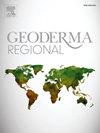Optimizing soil multifunctionality of coastal peat grasslands
IF 3.3
2区 农林科学
Q2 SOIL SCIENCE
引用次数: 0
Abstract
Soils have the capacity to provide a wide range of soil functions that can help address socio-environmental challenges, such as climate change and biodiversity loss. Here, we apply the Functional Land Management framework aimed at optimally balancing supply and demand of soil functions at a landscape-scale to drained coastal peat (Histosols) in Friesland, The Netherlands. We focus on the supply side by assessing the capacity of grassland peat soils with different topsoil types to provide five soil functions: climate regulation, habitat provision, nutrient cycling, water storage, and primary productivity. A field campaign was conducted in March 2022 to collect data on soil, water, vegetation, and management from 30 grasslands mapped as peat on the national soil map (Basisregistratie Ondergrond). Results revealed significant differences in above and belowground field conditions between peat with different topsoil types. Peat soils with a mineral cover are predominantly used as grasslands for dairy farming, with a clear differentiation in functioning between fields managed by organic and conventional farmers. Peat soils without a mineral cover are generally owned by nature organizations and managed as semi-natural grasslands aimed at optimizing aboveground habitat provision. Our results show that conventional agricultural management, including deep drainage and high fertilizer inputs, results in moderate to high nutrient cycling and primary productivity, along with low climate regulation, water storage and habitat provision. Extensification results in a decrease in primary productivity and nutrient cycling along with a strong increase in climate regulation, water storage, and habitat provision. To optimize landscape-scale provision of soil functions, we recommend promoting soil multifunctionality while maintaining moderately high yields on peat with a mineral cover. To benefit from the unique and yet unmet potential of peat soil for climate regulation and water storage, we recommend tailoring management of peat soils without a mineral cover to fully restore natural peatlands.
海岸带泥炭草原土壤多功能性优化研究
土壤有能力提供广泛的土壤功能,有助于应对气候变化和生物多样性丧失等社会环境挑战。在这里,我们应用了功能性土地管理框架,旨在在景观尺度上优化平衡土壤功能的供需,以排水的荷兰弗里斯兰沿海泥炭(Histosols)。通过对不同表土类型的草地泥炭土在气候调节、生境提供、养分循环、水分储存和初级生产力等五大土壤功能的评估,着重从供给侧进行研究。2022年3月开展了一项实地活动,收集了在国家土壤地图(basisregistricalongrond)上被标为泥炭的30个草原的土壤、水、植被和管理数据。结果表明,不同表层土壤类型的泥炭地上地下条件存在显著差异。有矿物覆盖的泥炭土主要用作奶牛养殖的草地,在由有机农民和传统农民管理的田地之间的功能有明显区别。没有矿物覆盖的泥炭土通常由自然组织拥有,并作为半自然草地进行管理,旨在优化地上生境的提供。研究结果表明,传统的农业管理,包括深排水和高肥料投入,导致中度至高的养分循环和初级生产力,以及低气候调节、水储存和栖息地提供。扩展导致初级生产力和养分循环的下降,同时气候调节、水储存和栖息地供应的显著增加。为了优化景观尺度上土壤功能的提供,我们建议促进土壤的多功能性,同时在有矿物覆盖的泥炭上保持适度的高产量。为了利用泥炭土在气候调节和水储存方面的独特潜力,我们建议对没有矿物覆盖的泥炭土进行量身定制的管理,以完全恢复天然泥炭地。
本文章由计算机程序翻译,如有差异,请以英文原文为准。
求助全文
约1分钟内获得全文
求助全文
来源期刊

Geoderma Regional
Agricultural and Biological Sciences-Soil Science
CiteScore
6.10
自引率
7.30%
发文量
122
审稿时长
76 days
期刊介绍:
Global issues require studies and solutions on national and regional levels. Geoderma Regional focuses on studies that increase understanding and advance our scientific knowledge of soils in all regions of the world. The journal embraces every aspect of soil science and welcomes reviews of regional progress.
 求助内容:
求助内容: 应助结果提醒方式:
应助结果提醒方式:


